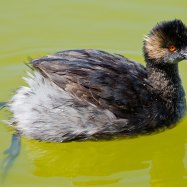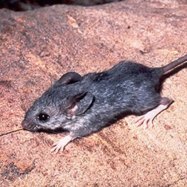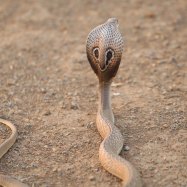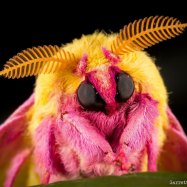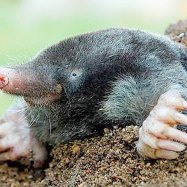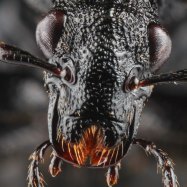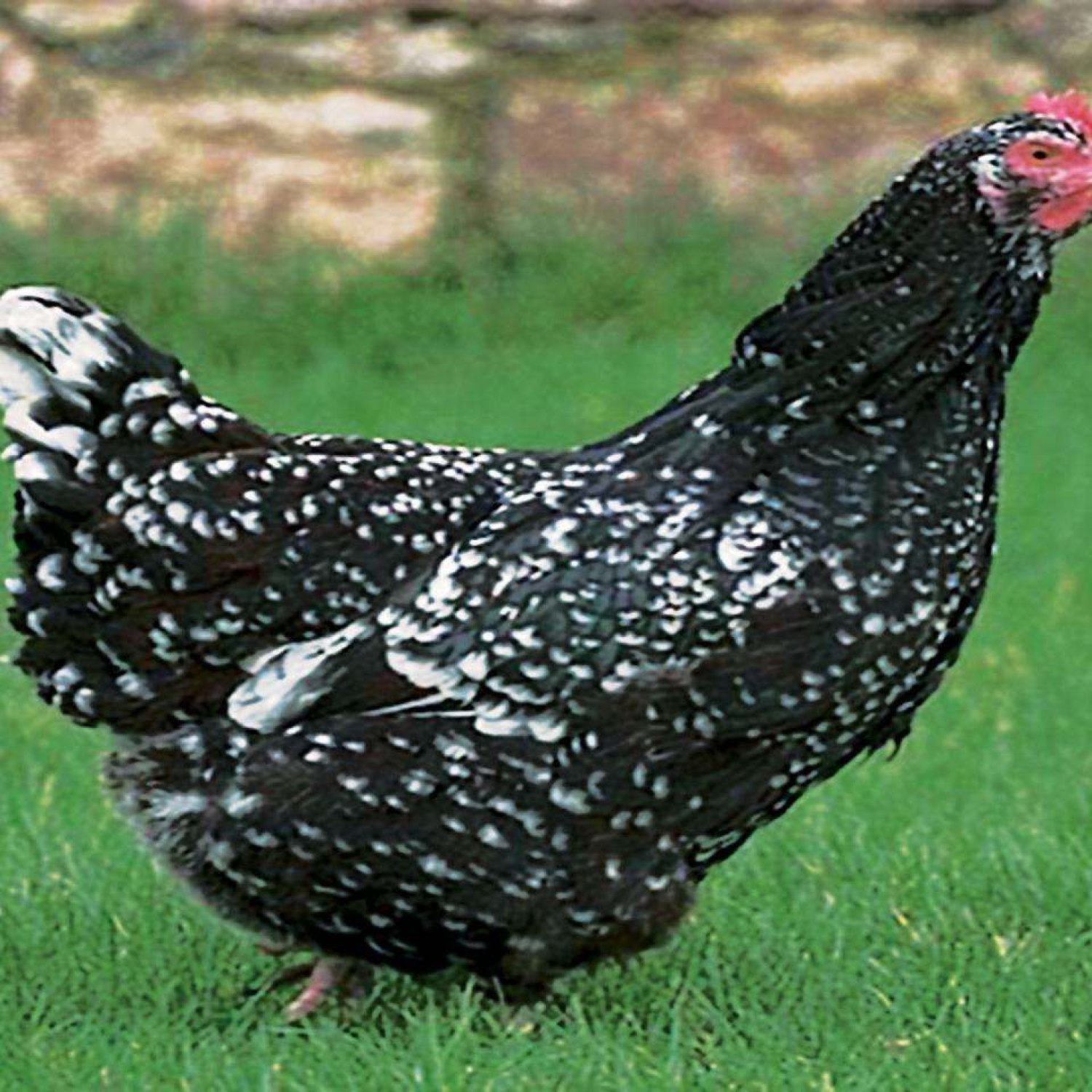
Sussex Chicken
20-25 inches
Sussex chickens are a popular breed known for their flavorful meat and beautiful appearance. These birds are medium-sized, muscular, and can grow to be 20-25 inches long. They are named after their place of origin, Sussex, England, and are part of the Phasianidae family. Considered a must-have in any backyard flock, these friendly birds are easy to care for and provide a steady supply of fresh eggs.
Animal Details Summary:
Common Name: Sussex Chicken
Kingdom: Animalia
Habitat: Domesticated, found in farms and backyards
The Sussex Chicken: A Domesticated Delight from Sussex, England
The world is full of different types of creatures, from the smallest insects to the largest animals. Among these creatures, birds hold a special place due to their diverse characteristics and captivating features. From their colorful feathers to their enchanting songs, birds have always been a source of fascination for many. One such avian species that has won the hearts of many is the Sussex Chicken Sussex Chicken.Scientifically known as Gallus gallus domesticus, the Sussex Chicken is a domesticated bird that belongs to the Phasianidae family and the Galliformes order. This medium-sized bird is a sight to behold with its striking white plumage and contrasting black feathers on the neck and tail. Originating from the quaint county of Sussex in England, this magnificent chicken has gained popularity worldwide due to its unique characteristics and adaptability.
Origins and History
The Sussex Chicken is a product of its environment and the history of Sussex, a county situated in the South-East of England. The rearing of livestock and poultry has been a significant part of the local economy in Sussex for centuries. The early settlers of this region recognized the potential of poultry farming, and thus, the Sussex Chicken was bred and developed.Initially, the chicken was bred for its meat and eggs, and it was used as a dual-purpose bird. However, due to its gentle and docile nature, it eventually gained popularity as a backyard pet and ornamental bird. The Sussex breed gained recognition in the late 19th century, and the first standards for its appearance were set by the Sussex Poultry Society in 1902 Senegal Parrot. Since then, the breed has been continuously improved and is now a popular choice for both hobbyists and commercial poultry farms worldwide.
Anatomy and Appearance
The Sussex Chicken is a medium-sized bird with a plump and muscular body. On average, these birds can grow up to 20 to 25 inches in length. They have a round head and a short beak, which is usually yellow in color. Their wattles and earlobes are also yellow, and their eyes are bright and alert.One of the most striking features of the Sussex Chicken is its plumage. They have white feathers covering their body, giving them a clean and crisp appearance. This uniform white coloration is broken by a contrasting black stripe on their neck and tail feathers, giving them a distinguished and regal look.
Habitat and Distribution
As the name suggests, the Sussex Chicken is a domesticated bird, meaning that it does not have a natural habitat in the wild. They are primarily found in farms and backyards, where they are reared for their eggs, meat, or as decorative pets. They can thrive in a variety of climates and are comfortable in both warm and cold temperatures.Although the Sussex Chicken is a native of Sussex, England, it is now found worldwide due to its adaptability and popularity. These birds can be found in different countries across Europe, North America, and even some parts of Asia. They have been exported to various regions and have adapted well to their new environments.
Feeding and Behavior
The Sussex Chicken is an omnivorous bird, meaning that it can consume both plants and insects. In the wild, they feed on grains, seeds, berries, and small insects. However, as a domesticated bird, their diet mainly consists of a commercial feed that is specifically designed for their nutritional needs.These birds are known for their gentle and docile nature, making them easy to handle and manage. They are social creatures and thrive in groups, and do not require much space to roam. However, they do tend to get aggressive with other birds during mating season, so it is advisable to keep them in pairs or small groups.
Significance in Agriculture
The Sussex Chicken has been an essential part of agriculture in Sussex, England, for centuries. Their dual-purpose characteristics make them a valuable asset for poultry farming, as they provide both eggs and meat for consumption. They are easy to manage, have a high feed conversion ratio, and are resistant to most common poultry diseases, making them a popular choice for commercial poultry farming.Apart from their economic significance, the Sussex Chicken also plays an important role in maintaining the eco-balance on farms. As omnivorous birds, they help in controlling insect populations, which can be harmful to crops. They also produce manure, which is rich in nutrients and is beneficial for fertilizing the soil.
Cultural Significance
The Sussex Chicken has not only impacted the agricultural sector but has also left its mark on popular culture. In Sussex, the chicken is considered a cultural icon, and it is often featured in local festivals and parades. It has also found its way into literature and art, with paintings and sculptures of this regal bird displayed in galleries and museums worldwide.Furthermore, the Sussex Chicken is a popular choice for poultry shows and competitions. Breeders and hobbyists showcase their best birds, and judges look for characteristics such as the bird's plumage, body shape, and size. These shows are a testament to the breed's popularity and its significance in the world of poultry.
Conservation Efforts
Despite its worldwide popularity, the Sussex Chicken is classified as a 'Minority Breed' by the Rare Breeds Survival Trust in the UK. This means that the breed's population is low, and conservation efforts are required to prevent it from becoming extinct. The decline in numbers can be attributed to the rise of commercial hybrid breeds, which are preferred for their higher productivity.To preserve the Sussex Chicken breed, various conservation programs and initiatives have been taken by organizations and individual breeders. These efforts involve breeding and maintaining purebred Sussex Chickens, educating the public about the breed's significance, and encouraging its use in poultry farming.
In Conclusion
In a world full of different avian species, the Sussex Chicken has firmly established its place, both empirically and culturally. From its origins in Sussex, England, to its worldwide popularity, this bird has captured the hearts of many with its striking appearance and gentle nature. Its role in agriculture and popular culture makes it a significant and valuable breed, which deserves recognition and preservation.Whether you are a poultry farmer or an enthusiast, a visit to Sussex, England, would be incomplete without encountering the striking white and black Sussex Chicken. With its regal appearance and gentle disposition, this bird is sure to leave a lasting impression on anyone who lays their eyes on it.

Sussex Chicken
Animal Details Sussex Chicken - Scientific Name: Gallus gallus domesticus
- Category: Animals S
- Scientific Name: Gallus gallus domesticus
- Common Name: Sussex Chicken
- Kingdom: Animalia
- Phylum: Chordata
- Class: Aves
- Order: Galliformes
- Family: Phasianidae
- Habitat: Domesticated, found in farms and backyards
- Feeding Method: Omnivorous
- Geographical Distribution: Worldwide
- Country of Origin: United Kingdom
- Location: Sussex, England
- Animal Coloration: White plumage with black neck and tail feathers
- Body Shape: Medium-sized and muscular
- Length: 20-25 inches
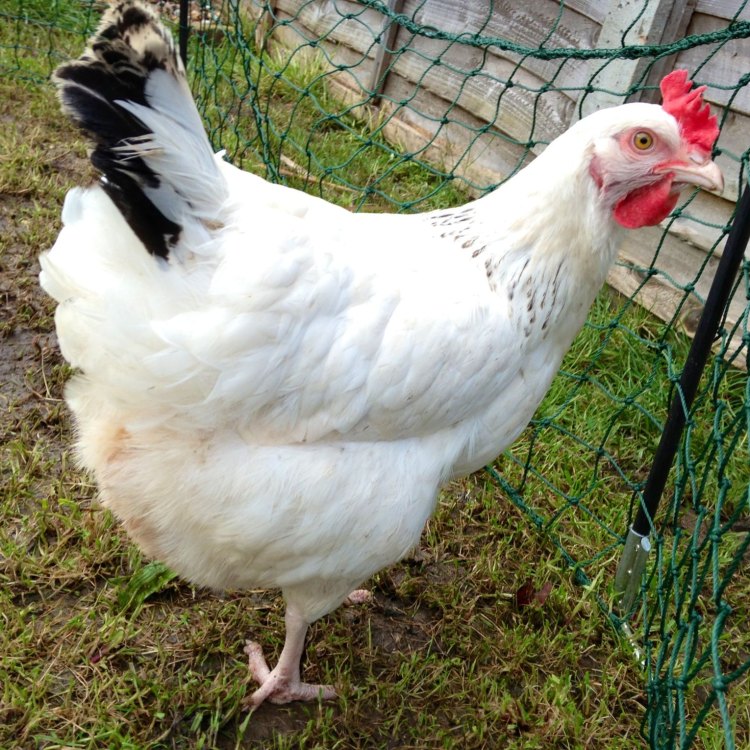
Sussex Chicken
- Adult Size: 4-7 pounds
- Average Lifespan: 5-10 years
- Reproduction: Sexual reproduction
- Reproductive Behavior: Males perform courtship displays to attract females
- Sound or Call: Cock-a-doodle-doo
- Migration Pattern: Non-migratory
- Social Groups: Flock
- Behavior: Social, active during the day
- Threats: Predators (including foxes, hawks, and snakes), diseases
- Conservation Status: Not listed
- Impact on Ecosystem: Provides meat and eggs for human consumption
- Human Use: Meat and egg production, ornamental purposes
- Distinctive Features: Black and white plumage, red comb and wattles
- Interesting Facts: 1. Sussex chickens are known for their excellent meat quality and are commonly raised for meat production. 2. They are docile and friendly birds, making them popular among backyard chicken keepers. 3. Sussex chickens are good layers and can produce a large number of eggs throughout the year. 4. They have a calm temperament and get along well with other chicken breeds. 5. The breed originated in Sussex, England, and has been recognized since the 19th century.
- Predator: Foxes, hawks, snakes
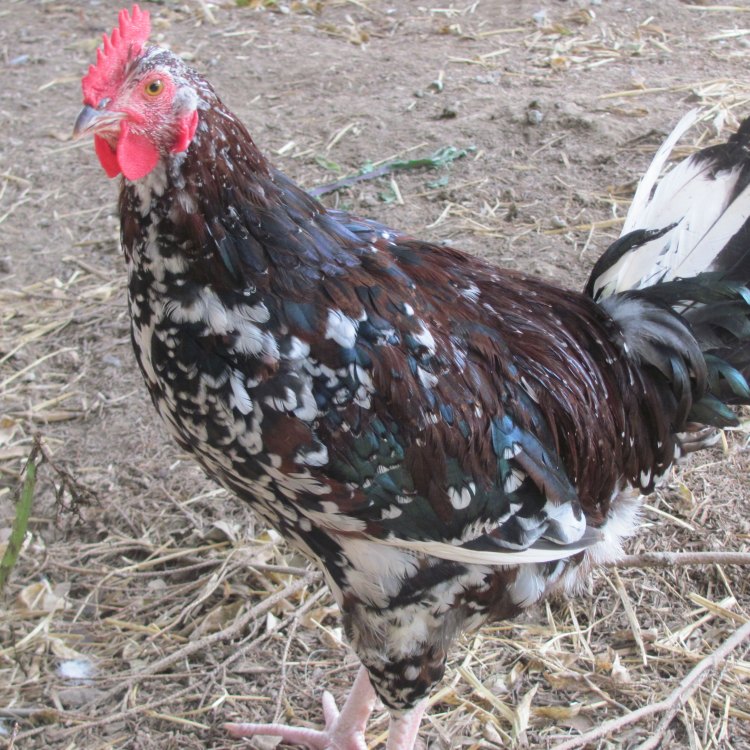
Gallus gallus domesticus
The Fascinating Sussex Chicken: A Social and Productive Breed
The world of chickens is vast and diverse, with various breeds that have been developed through years of selective breeding for specific purposes. One such breed is the Sussex chicken, a social and active bird that has been a favorite among chicken keepers for centuries.Originating from Sussex, England, this breed first gained recognition in the 19th century for its high meat and egg production. Over the years, Sussex chickens have become a popular choice for both commercial meat and egg production, as well as for ornamental purposes PeaceOfAnimals.Com.
But what makes these chickens truly unique and special? Let's take a closer look at their distinctive features, behavior, and impact on the ecosystem.
The Basics: Size, Lifespan, and Reproductive Behavior
The Sussex chicken is a medium-sized breed, with adults weighing between 4-7 pounds. They have an average lifespan of 5-10 years, making them a long-term commitment for chicken keepers.Like most chickens, Sussex chickens reproduce through sexual reproduction. The males, known as roosters, perform elaborate courtship displays to attract females for mating. This behavior is not only fascinating to watch but also essential for the continuation of the breed.
Distinctive Features and Behavior
One cannot miss a Sussex chicken thanks to its striking appearance. These birds have a black and white plumage with a hint of brown and a red comb and wattles. The combination of these colors makes them stand out in a flock of chickens Shollie.In terms of behavior, Sussex chickens are social animals and thrive in a flock. They are active during the day and can often be seen foraging and exploring their surroundings. These chickens are known to have a calm temperament and get along well with other chicken breeds, making them an excellent choice for mixed flocks.
Interesting Facts About Sussex Chickens
While many chicken breeds have unique or interesting features, Sussex chickens have some fascinating facts that set them apart from others. Here are five interesting facts about the breed:1. Renowned for their Meat Quality
One of the main reasons for the popularity of Sussex chickens is their meat quality. These birds are known for their plump and flavorful meat, making them a favorite for meat production. Their size and breed characteristics also contribute to their meat's tenderness, making them highly sought-after by poultry farmers and consumers.
2. Friendly and Docile
Unlike some other chicken breeds known for their aggressiveness, Sussex chickens have a docile and friendly temperament. This makes them a popular choice for backyard chicken keepers, especially for families with children. With proper handling and care, Sussex chickens can become loving and social pets.
3. Excellent Egg Production
In addition to their meat production, Sussex chickens are also known for their egg-laying abilities. These birds can lay a large number of eggs throughout the year, making them highly productive. This makes them a popular choice for egg production in many countries, contributing to the poultry industry's growth and development.
4. Non-Migratory Birds
Unlike many bird species that migrate to different regions for various reasons, Sussex chickens are non-migratory birds. They are content living in their designated areas and do not wander off in search of better resources. This behavior makes them easier to raise and keep in a specific location.
5. Originated in Sussex, England
As the name suggests, Sussex chickens were developed in Sussex, England, during the 19th century. The breed was selectively bred to produce high-quality meat and eggs, and its popularity quickly spread throughout the country and beyond. Today, it is one of the most recognized and preferred chicken breeds globally, thanks to its distinctive features and productive qualities.
Impact on the Ecosystem
Like all living organisms, Sussex chickens play a vital role in the ecosystem. As part of the food chain, they provide a source of food for predators such as foxes, hawks, and snakes. These birds also help maintain a balanced ecosystem by foraging on insects and other small creatures, preventing them from becoming overpopulated.With their high meat and egg production, Sussex chickens also play a crucial role in providing food for human consumption. This not only contributes to the global food supply but also provides livelihoods for many poultry farmers and supports the economy's growth.
Threats to Sussex Chickens and Conservation Status
Unfortunately, like all living creatures, Sussex chickens are vulnerable to threats that can affect their population. Predators, including foxes, hawks, and snakes, pose a significant threat to these birds, especially when they are free-ranging. These predators often see chickens as a source of food, and without proper protection, their numbers can significantly decline.Additionally, like all birds, Sussex chickens are susceptible to diseases that can impact their health and mortality rates. Therefore, it is necessary to provide them with proper care and a clean environment to keep them healthy and thriving.
Despite these threats, the Sussex chicken's population is currently stable, and they are not listed under any conservation status. However, it is always essential to take measures to protect and preserve these birds to ensure their continued existence and contribution to the ecosystem.
Human Use and Ornamental Purposes
Aside from their economic value, Sussex chickens are also commonly kept for ornamental purposes. With their beautiful and unique plumage, they make for a stunning addition to any backyard or farm. Their calm and friendly temperament also makes them popular among chicken enthusiasts for showing or displaying at poultry shows and fairs.The breed's versatility makes it appealing for various human uses, including meat and egg production, ornamental purposes, and even as pets. This has contributed to the Sussex chicken's popularity worldwide and its continued recognition as a valuable and productive breed.
In Conclusion: The Versatile and Fascinating Sussex Chicken
In summary, Sussex chickens are a valuable and fascinating breed of chickens. Their distinctive features, friendly behavior, and excellent production qualities have made them a popular choice among chicken keepers for centuries. They have not only contributed to the economy and food supply but also added to the beauty and diversity of the natural world.With proper care and protection, the Sussex chicken will continue to thrive and make a positive impact on the ecosystem and human society. As we appreciate these birds for their unique traits and qualities, let us also strive to protect and preserve them for future generations to enjoy.
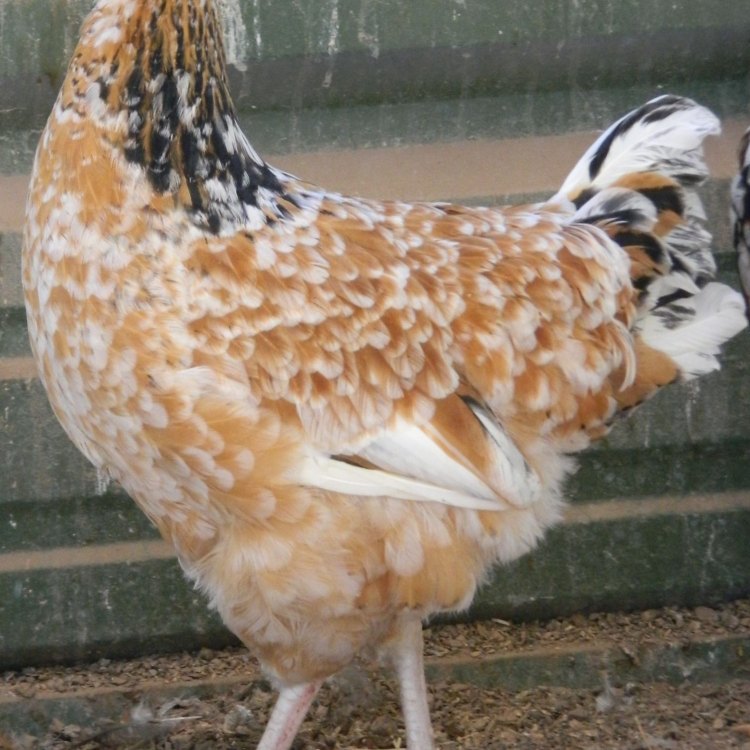
The Sussex Chicken: A Domesticated Delight from Sussex, England
Disclaimer: The content provided is for informational purposes only. We cannot guarantee the accuracy of the information on this page 100%. All information provided here may change without prior notice.

